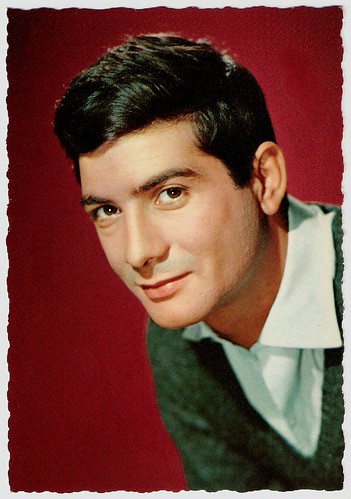
French postcard by E.D.U.G., no. 67. Photo: Sam Lévin.
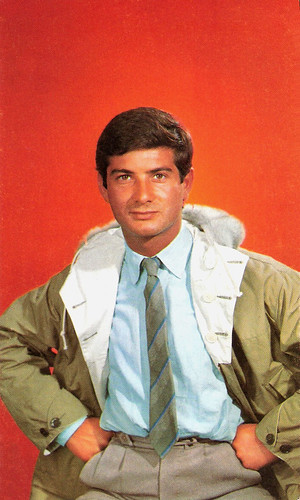
French postcard by E.D.U.G., no. 273, offered by Corvisart, Epinal. Photo: Sam Lévin.
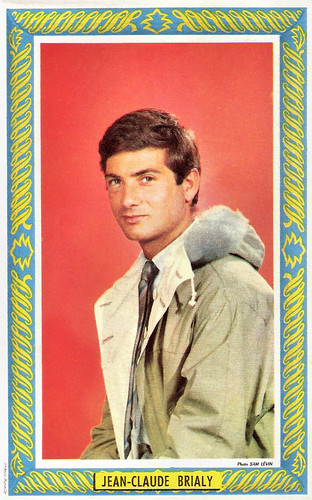
French postcard by St. Anne, Marseille. Photo: Sam Lévin.
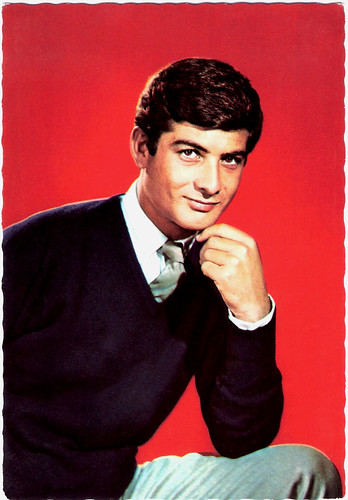
French postcard by E.D.U.G. (Editions du Globe), no. 165. Photo: Sam Lévin.
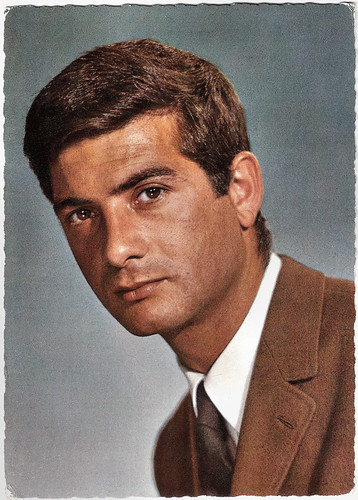
French postcard by E.D.U.G. (Editions du Globe), no. 327. Photo: Sam Lévin.
Acting as an early form of rebellion
Jean-Claude Brialy was born in Aumale, French Algeria (now Sour El-Ghozlane, Algeria), in 1933. He was the son of Roger Brialy, a colonel stationed in colonial Algeria with the French Army, and Suzanne Abraham. At the age of nine, he went with his family to various cities in France, settling after the war in Strasbourg, where he took his ´baccalaureate´.
Brialy showed great promise in drama and won first prize at the Conservatoire de Strasbourg. He detested his strict upbringing, and acting became an early form of rebellion. He had violent arguments with his father, who once locked the 15-year-old boy in to prevent him from attending rehearsals of a school play. Jean-Claude responded by smashing up the furniture. No doubt there was further trouble when Jean-Claude revealed that he was homosexual.
Against the wishes of his parents, he enrolled at the Centre Dramatique de l’Est (Eastern Centre of Dramatic Art in Strasbourg), to train to be an actor. Military service then intervened and Brialy found himself attached to an army film unit in the German town of Baden-Baden. There he made his first film, a short entitled Chiffonard et Bon Aloi/Chiffonard and Good Taste (Pierre Lhomme, 1954). His job also enabled him to go to shows and to meet actors, including Jean Marais.
Demobilised, he moved to Paris in 1954. There he scratched a living by small roles on stage and entertaining the queues outside the first-run cinemas on the Champs Elysees. He became friendly with a group of young critics and aspiring filmmakers who were taking over the influential journal Cahiers du Cinéma. At 21, he joined a Cahiers outing to Arles to see Jean Renoir's stage production of William Shakespeare's Julius Caesar. He made his film debut in a short directed by one of the Cahiers critics, Le Coup du berger/Fool's Mate (Jacques Rivette, 1956). Cahiers editor Eric Rohmer cast him as the lover in his 10-minute short La Sonate à Kreutzer/The Kreutzer Sonata (1956), an adaptation of the short story by Leo Tolstoy. Brialy appeared uncredited in two features by Louis Malle: Les Amants/The Lovers (Louis Malle, 1958) and Ascenseur pour l’échafaud/Elevator to the Gallows (Louis Malle, 1958), two instant classics starring Jeanne Moreau.
His first lead was in Le beau Serge/Handsome Serge (Claude Chabrol, 1958) as an idealistic Parisian student who returns after a ten-year absence to his provincial village and becomes obsessed with saving an old school friend who has become a hopeless alcoholic (played by the brooding Gérard Blain, often called the James Dean of France). The film, which won an award in Locarno, and the Jean-Vigo Prize, immediately attracted attention, and the performers (Brialy, Blain, and Bernadette Lafont) were widely acclaimed. Le beau Serge was followed by another film by Claude Chabrol, Les Cousins/The Cousins (1959), in which Brialy played the sardonic town cousin to Blain's simple country cousin.
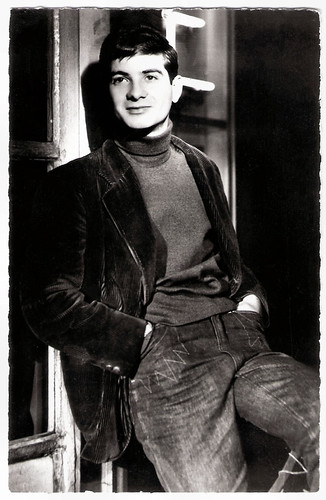
French postcard by Editions du Globe, Paris, no. 775. Photo: Studio Vauclair.
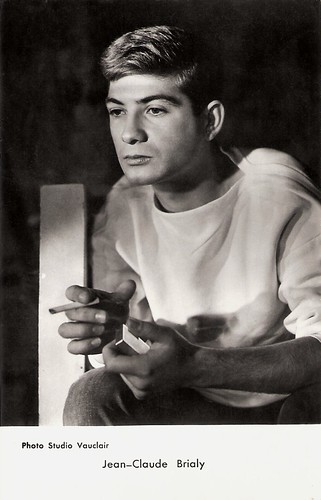
French postcard by Editions P.I., presented by Les Carbones Korès 'Carboplane', no. 1104A. Photo: Studio Vauclair.
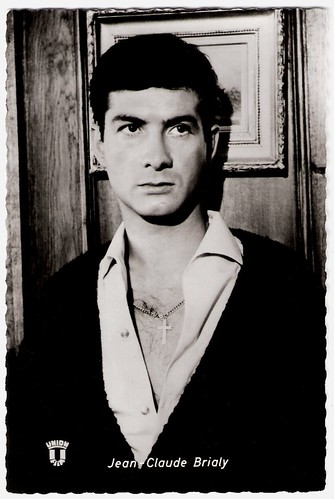
German postcard by Kolibri-Verlag G.m.b.H., Minden/Westf., no. 1383. Photo: Union-Film. Publicity still for Le gigolo/The Gigolo (Jacques Deray, 1960).
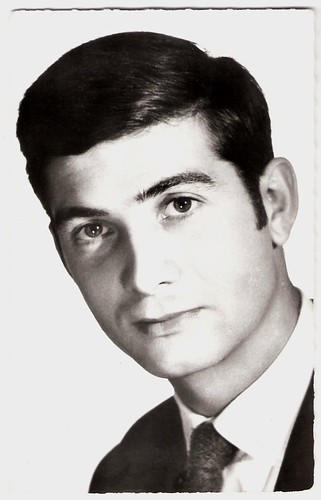
French postcard by Editions du Globe (E.D.U.G.), no. 832. Photo: Sam Lévin.
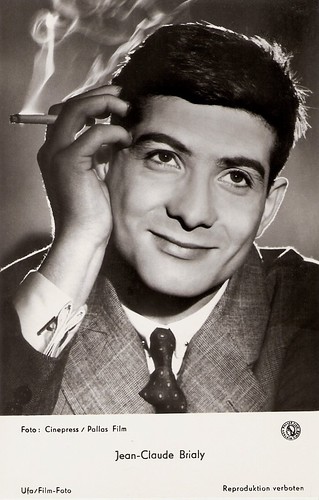
German postcard for Ufa (Universum-Film Aktiengesellschaft), Berlin-Tempelhof, no. FK 4505. Retail price: 25 Pfg. Photo: Cinepress / Pallas Film.
A period of frantic Renaissance
The young Turks of the Cahiers du Cinema formed the core of the Nouvelle Vague (New Wave). This film movement was a rebellion against the conventions of French cinema. As James Travers comments at French Films: ”Out went polished scripts, well-rehearsed performances and meticulously staged productions. In came spontaneity, improvisation, subversive politics, real human emotion, and fun.”
The Cahiers critics were starting to have an impact far greater than they could have anticipated and the French cinema seemed to be going through a period of frantic renaissance. The director became the intellectual author of the film; the stars were made more human, and the stories more enigmatic. Jean-Claude Brialy made several films with Nouvelle Vague filmmakers including Jean-Luc Godard, François Truffaut, Agnès Varda, Pierre Kast, and Jacques Rozier.
Ronald Bergan stated in The Guardian: “Where (Jean-Paul) Belmondo represented anarchy, (Jean-Pierre) Léaud youthful innocence and Blain sensitivity, Brialy brought cynicism, charm and sophistication to the films of the period.”
Brialy was the leading man in Godard’s ‘neo-realist musical’ Une Femme est une femme/Woman Is a Woman (Jean-Luc Godard, 1961), in which Anna Karina plays a stripper who wants to have his baby and turns to his best friend Jean-Paul Belmondo when he refuses. In the film Brialy directly addresses the audience with a line that became an epigram for the Nouvelle Vague: “It’s hard to tell if this is a comedy or a tragedy, but either way it’s a masterpiece.”
For Truffaut, he appeared opposite Jeanne Moreau in La Mariée était en noir/The Bride Wore Black (François Truffaut, 1968), and for Rohmer, he starred in Le Genou de Claire/Claire’s Knee (Éric Rohmer, 1970), in which he played a bearded cultural attache who is taking his last summer holiday as a bachelor at Annecy and becomes filled with desire for a young woman’s knee.
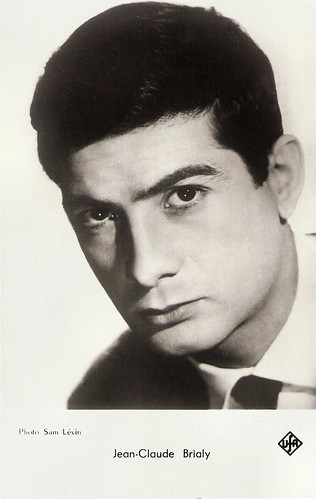
French postcard by Editions P.I., offered by Delespaul, Lille, no. FK 85. Photo: Sam Lévin / Ufa. (Editions P.I. was the licence holder for the Ufa postcards in France.)
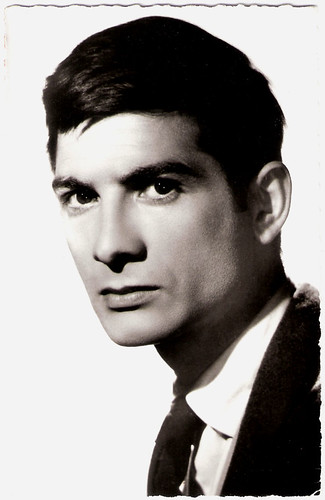
French postcard by Editions du Globe, no. 864. Photo: Sam Lévin.
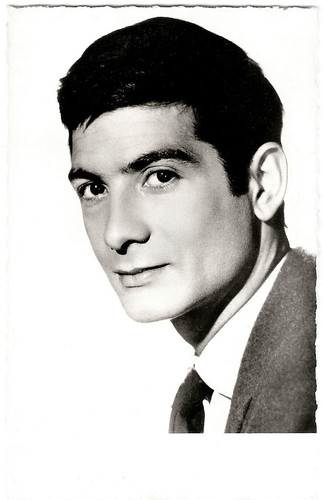
French postcard by Editions P.I., Paris, offered by Les Carbones Korès 'Carboplane', no. 1023. Photo: Sam Lévin.
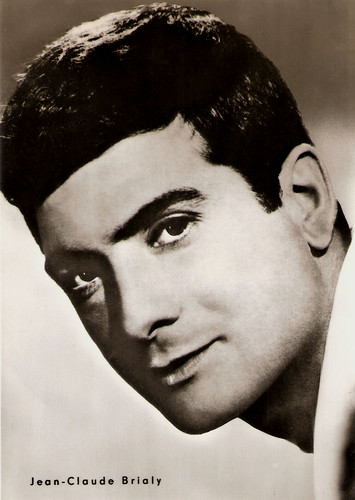
East-German postcard by VEB Progress Film-Vertrieb, Berlin, no. 19/71. Photo: Steffen.
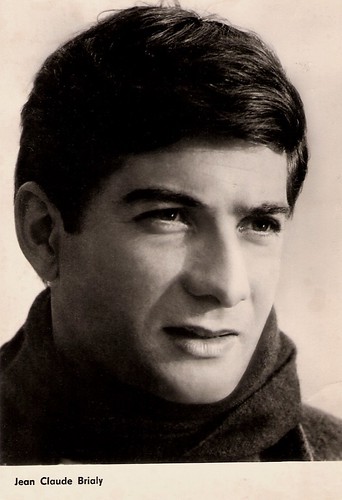
East-German card by VEB Progress Film-Vertrieb, Berlin, no. 1/972.
Gay uncle
Besides his work for the Nouvelle Vague, Jean-Claude Brialy also worked with many other well-known filmmakers. He made his feature film debut in Jean Renoir’s Elena et les hommes/Elena and her Men (1956) and played his first substantial role, in L’Ami de la famille/A Friend of the Family (Jacques Pinoteau, 1957). Then came a supporting role in Christine (Pierre Gaspard-Huit, 1958), starring Romy Schneider, who would become a close personal friend.
Brialy appeared with Alida Valli in Le Gigolo/The Gigolo (Jacques Deray, 1960), with Anthony Perkins in Le Glaive et la Balance/The Sword and the Balance (André Cayatte, 1963) and with Jane Fonda in La Ronde/Circle of Love (1964), Roger Vadim's adaptation of the classic Arthur Schnitzler play about various people having affairs. He was an asylum inmate in Le Roi de Coeur/King of Hearts (Philippe de Broca, 1966), which became a US hit.
In the following decades, he worked with major film directors like Luis Buñuel (Le Fantôme de la liberté/The Phantom of Liberty, 1974), Bertrand Tavernier (Le Juge et l’assassin/The Judge and the Assassin, 1976) and Ettore Scola (La Nuit de Varennes/That Night in Varennes, 1982). He was equally attracted to popular comedies, such as Le Maître-nageur/The Swimming Instructor (Jean-Louis Trintignant, 1978) and Pinot simple flic/Pinot, Simple Cop (Gérard Jugnot, 1984).
He reunited with Claude Chabrol and Bernadette Lafont for Inspecteur Lavardin/Inspector Lavardin (Claude Chabrol, 1986) in which he played a gay uncle. Other notable appearances include Les uns et les autres/Bolero (Claude Lelouch, 1981), Mortelle Randonnée/Deadly Circuit (Claude Miller, 1982), and La Reine Margot/Queen Margot (Patrice Chéreau, 1994) starring Isabelle Adjani.
Brialy also directed a dozen (TV) films himself, including Églantine (1971), an enchanting story set in the 19th century of a boy's visit to his grandmother, and Un Amour De Pluie/Loving in the Rain (1974) starring Romy Schneider as a woman who takes her daughter to a summer resort in search of a love affair. He often appeared in supporting roles and was nominated for a César for the best supporting actor for his role in Le Juge et l’Assassin/The Judge and the Assassin (Bertrand Tavernier, 1976), but he won the César for Les Innocents/The Innocents (André Téchiné, 1988).
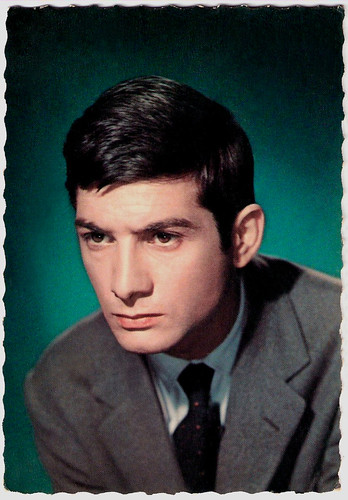
French postcard by E.D.U.G., no. 43. Photo: Sam Lévin.
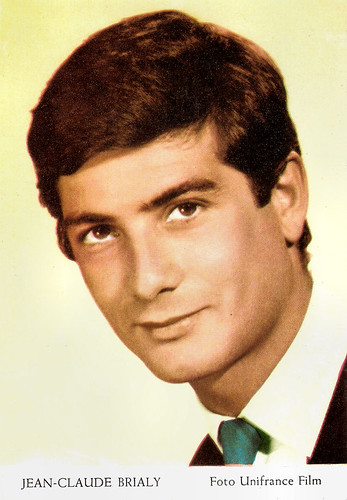
Vintage card. Photo: Unifrance Film.
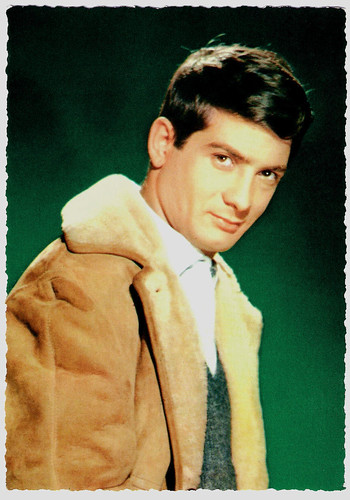
French postcard by C.B.
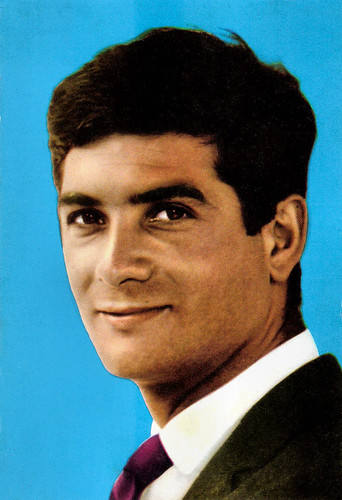
Spanish postcard by Postalco, Barcelona, no. 20/7. Photo: Unifrance Film.

French postcard by E.D.U.G., no. 220. Photo: Studio Petri.
Bon Vivant
Jean-Claude Brialy came to personify all that is best in French culture. A bon vivant, he started his own restaurant in 1966: the popular L'Orangerie, on the Île Saint-Louis in Paris, which he owned for two decades. He was a natural conteur, and he revelled in his numerous television and radio appearances.
As a lover of literature, he read extensively and wrote several best-selling books, including the memoirs, Le Ruisseau des singes (River of Monkeys) (2000) and J'ai oublié de vous dire... (I Forgot to Tell You ...) (2004). And he was also a man of the stage. His theatrical successes include Georges Feydeau’s La Puce à l’oreille (A Flea in Her Ear, 1968) and Hotel Paradiso (1974), and Sacha Guitry’s Desiré (1984).
When he wasn’t treading the boards, he was helping to direct theatres and film festivals. As James Travers writes at Films de France: “It’s no wonder that he became one of the best-loved and most highly respected figures in France.” For his exceptional contribution to French culture, he was awarded the Légion d’honneur (the Legion of Honour).
In his last film, made for television, Brialy gave his best performance in years, as the gay Jewish poet Max Jacob in Monsieur Max (Gabriel Aghion, 2007), who converted to Catholicism and died in a Gestapo internment camp.
Following a long illness, Jean-Claude Brialy died of cancer in 2007, in his house in Monthyon, France. He was 74. In more than a half-century, Brialy appeared in 185 films and television shows. He is cited in The Guardian saying: "Out of the 185 films, I must admit that I've enjoyed myself 185 times".

Spanish postcard by Postalcolor, Hospitalet (Barcelona), no. 80. Photo: Sam Lévin.

French postcard by Editions P.I, Paris. Photo: Ektachrome Anders.
Trailer for Une Femme est une femme/Woman Is a Woman (1961). Source: Kanál uživatele precija (YouTube).
Trailer of Le genou de Claire/Claire’s Knee (1970). Source: Video Detective (YouTube).
French trailer of Inspecteur Lavardin (1986) . Source: Cohen Film Collection (YouTube).
Sources: James Travers (French Films), Ronald Bergan (The Guardian), Tim Weiner (The New York Times), Jean Roy (L’Humanité), Adam Bernstein (Washington Post), Hal Erickson (AllMovie), The Independent, Film Reference, Wikipedia and IMDb.
This post was last updated on 10 August 2023.
3 comments:
Wonderful post Bob. full of interesting info. I will never forget Brially in Claire's Knee, an all time favorite of mine.
I loved the clip from Woman is a Woman! I wonder if his parents ever were happy with his success.
What an incredibly handsome man. I love your posts--they're always filled with such interesting facts. I enjoyed every word! And all the pictures...they're wonderful. I apologize for missing this week's PFF. You have been such a great support. I was away from my desk--and the computer for a time. It was a very hard week. I think of you and your family--your boy. I have a son with Autism. He's doing very well and is fully grown. Very proud of that young man. Have a lovely rest of the week.
Post a Comment